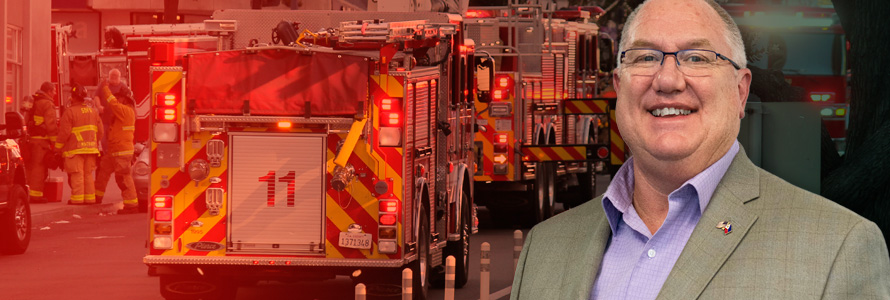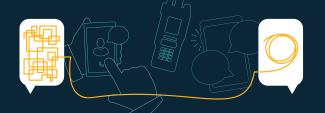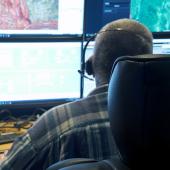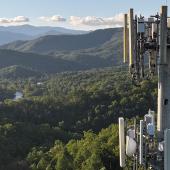Gary McCarraher, FirstNet Authority Senior Public Safety Advisor for the Fire Service, came to the FirstNet Authority after 45 years in fire and EMS, rising through the ranks and serving as fire chief for three departments. During his career, Gary was an adjunct professor in Fire and Emergency Management, and he spent 20 years as a local emergency management director.
We sat down with Gary to talk about his career, his time on the FirstNet Authority Public Safety Advisory Committee (PSAC), and how he believes FirstNet is increasing first responder safety.
How did you see communications tools and methods change during your career?
McCarraher: Communications over my career increased dramatically. When I first started, agencies were lucky if they had one or two portable radios – and those radios were often for chief officers to talk to dispatch. As a firefighter, if you needed something while working, you often had to relay your message through other firefighters back to the chief officer. Technology progressed from there to where individual officers had radios, or there was at least one radio per vehicle, which enhanced communications significantly.
By the time I retired, communications had completely transformed. I remember one instance about a year before I retired where I traveled to Houston for a conference and a surprise major storm hit the northeast, so I couldn’t return as planned. My agency was responding to the two feet of snow that fell during the storm. I was able to handle all of the incident conferences from Houston, as well as stay connected with my staff and monitor the CAD (computer-aided dispatch) system from my hotel. A situation like that would have been unimaginable early in my career.
What made you want to work with the FirstNet Authority?
McCarraher: I’ve been fortunate to work with the FirstNet Authority for several years now. I was chair of the International Association of Fire Chiefs (IAFC) Communications Committee when the Middle Class Tax Relief and Job Creation Act of 2012 was enacted, forming the First Responder Network Authority. Due to my involvement with IAFC, I was selected as one of the first members of the PSAC.
The PSAC is a critical foundational piece of FirstNet. Early in the development of FirstNet, the PSAC held several focus groups, bringing together experts on LTE and public safety to talk about what a broadband network designed for first responders would truly look like. Without those early conversations, we would have never gotten all of the information needed to inform the Request for Proposals. And now that a contract is in place and network deployment is underway, the PSAC serves as an important forum to ensure FirstNet is meeting the needs of public safety agencies. The PSAC provides important insight about tools first responders need, but cannot get. The representatives on the PSAC make the experiences of first responders real for FirstNet and the FirstNet Authority.
After seeing the effect of increasing access to portable radios and seeing the early stages of FirstNet through the PSAC, I became very interested in how technology is evolving to enhance communications for first responders. When I had the opportunity to join the FirstNet Authority after I retired, I took it so I could help other fire chiefs and their agencies understand broadband technology and how it can enhance their operations and keep their firefighters safe.
Where do you see FirstNet having the greatest impact for fire services personnel?
McCarraher: FirstNet is enabling technology that will save time and money, while helping to protect first responders. Unmanned aerial vehicles (drones) are being used for perimeter searches, which is much quicker and more efficient than sending firefighters. And location-based services allow for improved asset tracking. FirstNet is working to enhance these services so fire ground commanders can know exactly where their firefighters are and whether they need help.
Ultimately, FirstNet will keep first responders safer. As technology advances, it provides us with more data. For example, the smartwatches that many people wear every day to count steps and get text notifications can also read several different pieces of biometric data, including pulse, EKGs, and blood pressure. As an incident commander in the fire service, getting that kind of information on firefighters as they respond to an incident would be invaluable. It would allow a supervisor to pull someone in need of medical care out of a hazardous situation immediately. FirstNet offers the infrastructure to be able to share data like that in a meaningful way.
Making responders safer helps them to serve their communities more quickly and efficiently. Technology enabled through FirstNet will give first responders and commanders greater situational awareness before they arrive on scene at an incident and as it unfolds. It gives public safety increased insight, which in turn allows leaders to make better decisions and better serve their communities.
In your role as the FirstNet Authority’s Fire Services subject matter expert, how do you work with public safety?
McCarraher: First and foremost – I’m here to listen. On the fire services team here at the FirstNet Authority, we have a combined 100+ years of experience. We can use that experience to guide what we do, but we are retired and no longer in the field. That’s where I turn to work with the current fire services community. We want to make sure what we’re developing is accurate and useful for those on the front lines today, so I seek out feedback and bring it back to inform everything we do.
I want to hear from you on how you’re using FirstNet and other technology. I want to know how the network is working for you. In turn, I can help share those successes with other agencies around the country.
I’m also here to help educate. FirstNet is a new tool, and it is incumbent on us at the FirstNet Authority to reach out to the fire service community, to explain the tool, what it can do for operations, and why agencies should consider using it. As part of that education effort, I encourage members of the fire service to come to me with questions. If you’re interested in how it works and why, my team and I can provide you with that information, which will help you implement it in the most effective manner possible.
I look forward to working with the fire services community to help agencies across the nation understand how FirstNet can benefit operations and help keep firefighters safe.
FirstNet belongs to public safety, and the FirstNet Authority’s job is to help ensure it will evolve in the future to continue to meet those needs. To share your feedback or ask a question about FirstNet for the fire services, contact Gary McCarraher, Senior Fire Services Advisor at Gary.McCarraher@firstnet.gov or call 240-449-9378.
You can also sign up for Gary’s Fire Services Take newsletter, or visit our page for fire services.




















